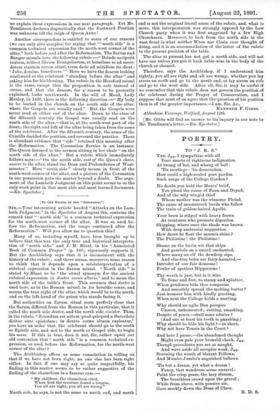LTO THE EDITOR OF THE " SPECTATOR;]
BIE,—Your interesting article headed "Attacks on the Lam- beth Judgment," in the Spectator of August 8th, contains the remark that " north side' is a common technical expression for the north-west corner of the altar. It was so used be. fore the Reformation, and the usage continued after the Reformation." Will you allow me to question this ?
Many of us, including myself, have been brought up to believe that this was the only true and historical interpreta- tion of " north side," and J. H. Blunt, in his " Annotated Book of Common Prayer" (p. 160), vigorously supports it. But the Archbishop says that it is inconsistent with the history of the rubric ; and there seems, moreover, some reason to think that it depends upon a misinterpretation of a rubrical expression in the Sarum missal. "North side" is stated by Blunt to be " the ritual synonym for the ancient rubrical expression in dextro cornu altaris," and to mean the north side of the table's front. This assumes that dexter is used here, as in the Roman missal, in its heraldic sense, and means the true right of the altar, which would be to the north, and on the left-hand of the priest who stands facing it.
But authorities on Sarum ritual seem perfeely clear that the Sarum differed from the Roman in this particular, that it called the south side dexter, and the north side sinister. Thus, in the rubric, " Sciendum est autem quod quicquid a Sacerdote dicitur ante epistolam ; in dextro cornu altaris expleatur,' you have an order that the celebrant should go to the south or Epistle side, and not to the north or Gospel side, to begin his mass. If this is true, does it not, Sir, rather upset our old contention that " north side " is a common technical ex- pression, so used before the Reformation, for the north-west comer of the altar P
The Archbishop offers us some consolation in telling us that if we have not been right, no one else has been right either. In fact, if one may say so quite respectfully, his finding in this matter seems to be rather suggestive of the finding of the chameleon in a famous case :- " My children, the chameleon cried, When first the creature found a tongue, You all are right, you all are wrong."
North side, he says, is not the same as north end, and north
end is not the original literal sense of the rubric, and, what is more, this interpretation was strongly opposed by the Low Church party when it was first suggested by a few High Churchmen. Moreover, to look from the north side in the west front is what neither Wren nor Cosin ever thought of doing, and it is an accommodation of the letter of the rubric to the present position of the table.
The altar at present has not got a north side, and will not have one unless you put it back table-wise in the body of the church or chancel.
Therefore, says the Archbishop, if I understand him rightly, you all are right and all are wrong; whether you lay stress on north and go to the north end, or lay stress on side and go to the west side. After all, Sir, it may be useful if we remember that this rubric does not govern the position of the celebrant during the Prayer of Consecration, and I suppose that most of us agree that the question of his position then is of the greater importance.—I am, Sir, &c., KENNETH F. GIBBS. Alclenham Vicarage, Watford, August 11th.
[Mr. Gibbs will find an answer to his inquiry in our note to Mr. Tomlinson's letter.—ED. Spectator.]


































 Previous page
Previous page